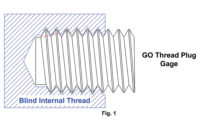Vision & Sensors - Image Analysis
Encoder Input Improves Part Inspection
Adding an encoder to provide a distance-based input trigger can eliminate automated inspection errors.

On a bottling line, a vision sensor inspects for label skew. Source: Baumer

1 of 3: This illustrates what happens when the speed of the part changes while the distance between the part presence and imaging sensors remains the same. Source: Baumer

2 of 3: This illustrates what happens when the speed of the part changes while the distance between the part presence and imaging sensors remains the same. Source: Baumer

3 of 3: This illustrates what happens when the speed of the part changes while the distance between the part presence and imaging sensors remains the same. Source: Baumer








Typical Inspection Process
Time- Velocity Examined
Practical Implications of Variable Line Speed
Adding a Distance Component Using an Encoder
TECH TIPS
|
Looking for a reprint of this article?
From high-res PDFs to custom plaques, order your copy today!












